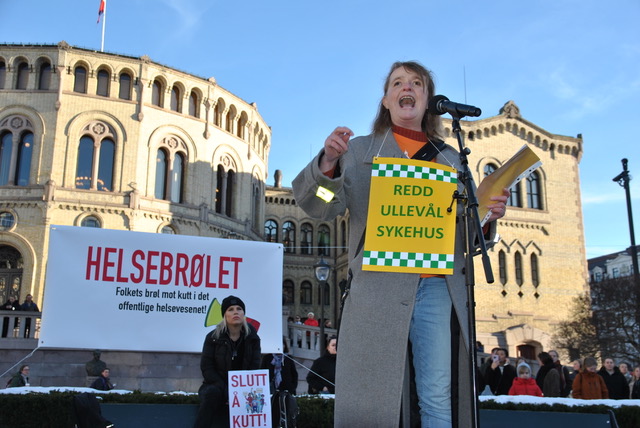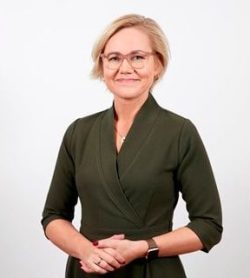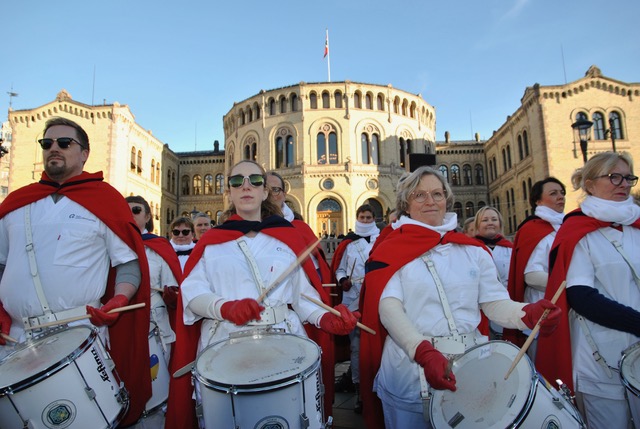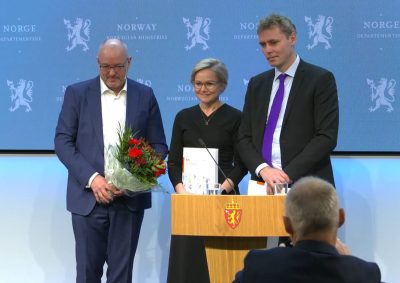Lots of unhappy Norwegians have been yelling at their government this winter. Several nurses even went so far as to organize a public uproar outside Parliament this week, to protest budget cuts in the health care sector, especially at hospitals and nursing homes.

It’s all part of what commentators and government critics are calling a “health care crisis” in Norway, even as money from gas and oil sales pours into state coffers and the country’s economy remains surprisingly strong. State-run hospitals all over the country have been ordered to cut expenses and staffing. That’s resulted in entire wards being shut down and longer waits for non-critical operations or other procedures, while lots of doctors and nurses are quitting to work in the more lucrative private sector.
That’s led to an increase in patients relegated to beds placed in hospital corridors, and the shut-down of a popular maternity unit in Oslo called the ABC Clinic that catered to those wanting natural deliveries. There have also been cuts in psychiatric care after years of concerns that more is needed, and staffing cuts aross the board. Oslo University Hospitals (OUS) were orded to cut the equivalent of 500 full-time positions.
OUS staff members were behind the public uproar (called Helsebrølet, literally “roar for health”) on Tuesday against all the cuts in the health sector. “The goal is to open the eyes of the government (responsible for state hospital budgets) to see how all these cuts affect very many people and the public health service,” said Tina Tuft, a nurse at OUS who was among the organizers of the noisy public display of dissatisfaction. They claimed on social media that their group “can’t stand to see health care services decline in one of the world’s wealthiest countries” because of budget cuts and a lack of priorities from the government.
Tempers flared when Health Minister Ingvild Kjerkol of the Labour Party asked hospital administrators in January to set their own “tougher priorities” and identify what they “can do less of.” She also asked them “to reduce “over-use” of laboratories and X-rays and even identify “treatment methods that can be phased out.” Kjerkol, who has a habit of smiling even when delivering bad news, claimed that “the most expensive and most risky treatment can have poor effect.”

It didn’t take long for a barrage of criticism against Kjerkol and the entire government, which often brags of “world-class” health care in Norway. Not true, claim many over-worked doctors and nurses. Political opponents were also quick to react, with some calling Kjerkol’s demands “a slap in the face to the nearly 250,000 Norwegians waiting in line” for health care procedures.
They claim that budgets allotted to state hospitals are too weak, leading to a “brain drain” of medical personnel to the private sector where pay can be higher and duty shifts less demanding. OUS doctors warned that the cuts demanded could even be life-threatening. They’re already having to release patients earlier than they think is medically defensible, in order to free up beds for others.
Such early releases, meanwhile, are also contributing to another “crisis” at nursing homes in Norway. They’re generally run by local governments, which have been struggling to care for released hospital patients too ill to be sent home. Inadequate staffing and poor care at nursing homes, especially in Oslo, were the subject of a recent documentary on state broadcaster NRK that shocked everyone watching, and led to a political shake-up at City Hall. The nursing homes known as helsehus and meant to provide convalesecent care are now being reorganized and, officials hope, improved but challenges remain, not least to find competent staff willing to work for still-relatively low pay.

Meanwhile anger has erupted over high salaries paid to administrators in Norway’s large health care bureaucracy. Newspaper Klassekampen has reported how 70 state health care executives earn more than the prime minister (around NOK 1.8 million, or USD 180,000 a year) and 198 earn more than the health minister (who earns around NOK 1.6 million). That’s roughly three times what a nurse is paid, and calls continue to go out for better pay for nurses to make the important profession more attractive and offset a chronic shortage of nursing staff.
Many are also furious that the state is nonetheless moving forward with plans to shut down Oslo University Hospital Ullevål, Norway’s largest, and build a new high-rise hospital at the site of the national hospital (Rikshospitalet). That project has drawn protests for years, from doctors, nurses and patients, with actress Lise Fjeldstad famously complaining on national radio recently that Health Minister Kjerkol was “spending billions on a hospital no one wants” while cutting services and staffing at Ullevål. A group of doctors and medical school professors also recently urged Kjerkol to instead spend such money on improving existing services and facilities. On Tuesday, however, the government gave the green light to start construction of the new facility that many professionals fear won’t meet local and national needs. Norway has a history of building new hospitals that are too small when they finally open.

Kjerkol got some support earlier this month from a state-appointed commission charged with reviewing how health care is organized in Norway. Dr Gunnar Bovim, who led the commission, claims the current system will eventually break down under the burden of an aging population. He warns it will be necessary to have fewer medical personnel per patient, more automation and “hard prioritizing.” The commission proposes a merger of all health care under the state, but Kjerkol quickly rejected that. She did support proposals for more flexibility among staffers, with midwives, for example, both handling births and following up pregnant patients and new mothers at local health stations.
Automation, meanwhile, is not always doing well, given ill-fated attempts to roll out a new “health platform” meant to digitalize patient journals into a national system. It debuted at St Olav’s Hospital in Trondheim late last year and has sparked chaos ever since because of various flaws, technical errors and a lack of information for staffers forced to use it. The idea, launched by current Prime Minister Jonas Gahr Støre when he was health minister in 2012-2013, was to consolidate Norway into a single health care reporting system, so doctors and nurses could access patients’ records all over the country. It’s so far been a NOK 3.8 billion disappointment that already needs hundreds of millions more to fix problems. The board of the regional health administration Helse Midt-Norge, which encompasses Trondheim, decided last month that further use of the system must be postponed until its functionality improves.
After all her dire warnings in January, and all the complaints that poured in, Kjerkol ended up offering an extra NOK 2.5 billion to state hospitals, in addition to more money bound to be allocated after Finance Minister Trygve Slagsvold Vedum failed to account for inflation in his total state budget for 2023. Her goal, she said, is to provide hospitals with “more predictabiity” even though they’ll still need “to make tough priorities.” Even though Norway is wealthier than ever before, Kjerkol and the rest of the government cite expenses tied to Russia’s war on Ukraine, inflation, the energy crisis and more economic uncertainty.
“I wish I could promise more money and better times,” she told news bureau NTB, “but I have to be honest about the demanding situation we’re all in, and that reduces the room we have for negotiations with our hospitals.” She said restructuring will continue after the health care commission “gave us a new reality check.”
She was quickly criticized for creating confusion around hospital budgets. OUS administrators responded to the new budget allocation by warning that cuts would still be made. The extra money would be put to good use, they claimed, but wouldn’t ward off the 500 job cuts.
That suggests the roar of complaints will continue. “We need you and the rest of the rest of the power structure, to help us,” the rally organizers wrote in newspaper Dagsavisen this week, directing their comments at Kjerkol and Støre. “We want to keep our jobs, and be safe when we give birth, get sick and grow old. The health care system is the backbone of our welfare state. Therefore it must receive the resources necessary.” More protest marches loom.
NewsinEnglish.no/Nina Berglund

